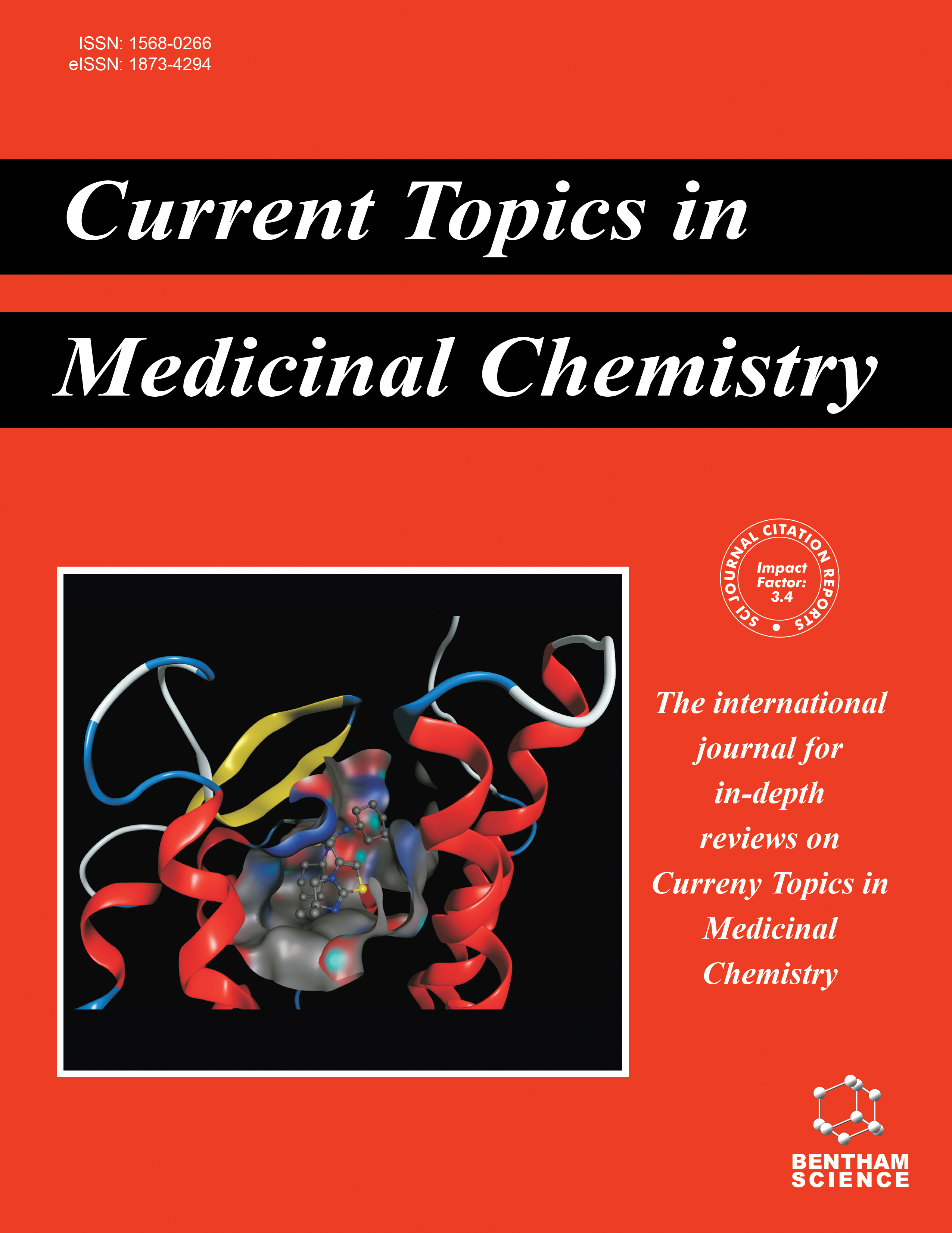- Home
- A-Z Publications
- Current Topics in Medicinal Chemistry
- Previous Issues
- Volume 11, Issue 5, 2011
Current Topics in Medicinal Chemistry - Volume 11, Issue 5, 2011
Volume 11, Issue 5, 2011
-
-
Editorial [Hot topic: Metal Chelation (Guest Editors: Paul V. Bernhardt & Des R. Richardson)]
More LessAuthors: Paul V. Bernhardt and Des R. RichardsonComplexes of essential metal ions (e.g., iron, copper, zinc) as well as exogenous metal ones (platinum, ruthenium, gold) have found many pharmacological applications. The best and most well known example is the cancer chemotherapeutic cisplatin, cis-[Pt(NH3)2Cl2], that has made a significant impact in the treatment of a number of tumors e.g. small cell lung cancer, ovarian carcinoma etc. In this volume of Current T Read More
-
-
-
The Medicinal Chemistry of Novel Iron Chelators for the Treatment of Cancer
More LessCancer is one of the leading causes of death worldwide and there is an increasing need for novel anti-tumor therapeutics with greater selectivity and potency. A new strategy in the treatment of cancer has focused on targeting an essential cell metabolite, iron (Fe). Iron is vital for cell growth and metabolism, forming a crucial component of the active site of ribonucleotide reductase (RR), the rate-limiting enzyme in DNA synth Read More
-
-
-
Peptide Targeted Copper-64 Radiopharmaceuticals
More LessAuthors: Michelle T. Ma and Paul S. DonnellyPeptide targeted 64Cu-labelled diagnostic agents for positron emission tomography are viable candidates for molecular imaging of cancer. In a clinical setting, optimal image quality relies on selective tumor uptake of the 64Culabelled radiotracer. The three components of the radiotracer construct - the chelate group, linker and targeting peptide - all influence the biodistribution of the 64Cu-labelled radiotracer in vivo. Low Read More
-
-
-
Transition Metal Based Anticancer Drugs
More LessWith an ageing baby-boomer population in the Western World, cancer is becoming a significant cause of death. The prevalence of cancer and all associated costs, both in human and financial terms, drives the search for new therapeutic drugs and treatments. Platinum anticancer agents, such as cisplatin have been highly successful but there are several disadvantages associated with their use. What is needed are new compou Read More
-
-
-
Reorganizing Metals: the Use of Chelating Compounds as Potential Therapies for Metal-Related Neurodegenerative Disease
More LessAuthors: Alison C. Badrick and Christopher E. JonesMetal ions, particularly copper, zinc and iron, are implicated in several amyloidogenic neurodegenerative disorders. In the brain, as elsewhere in the body, metal ion excess or deficiency can potentially inhibit protein function, interfere with correct protein folding or, in the case of iron or copper, promote oxidative stress. The involvement of metal ions in neurodegenerative disorders has made them an emerging target for Read More
-
-
-
Studies on the Biotransformations and Biodistributions of Metal-Containing Drugs Using X-Ray Absorption Spectroscopy
More LessAuthors: Jade B. Aitken, Aviva Levina and Peter A. LayMost metal-based drugs are pro-drugs; therefore, it is essential that methods are developed to follow their speciation in biological fluids, cells and tissues. This will lead to both a better understanding of the factors that affect their efficacies and toxicities and, consequently, to the design of new and superior drugs. The use of X-ray absorption spectroscopy on bulk samples, and X-ray microprobe techniques on cells and tissues, pr Read More
-
-
-
Quadruplex DNA: A Promising Drug Target for the Medicinal Inorganic Chemist
More LessCompounds that can bind to and stabilize quadruplex DNA structures in telomeres, or induce formation of such structures from ssDNA, represent an attractive general approach to the treatment of cancer. Until recently most effort in this area has been directed towards the synthesis of organic compounds for this purpose. More recently there has been growing recognition that metal complexes offer a number of potential advan Read More
-
-
-
Synthetic and Natural Products as Iron Chelators
More LessAuthors: Philip C. Sharpe, Des R. Richardson, Danuta S. Kalinowski and Paul V. BernhardtAn evaluation of existing and proposed Fe chelators, both synthetic and natural products, for the treatment of Fe-overload disease must address a number of issues. There are fundamental parameters that determine the efficacy of a drug: absorption, distribution, metabolism, clearance and toxicity. However, the administration of chelators for Fe overload aims to generate Fe complexes in vivo that are able to be excreted. He Read More
-
Volumes & issues
-
Volume 25 (2025)
-
Volume 24 (2024)
-
Volume 23 (2023)
-
Volume 22 (2022)
-
Volume 21 (2021)
-
Volume 20 (2020)
-
Volume 19 (2019)
-
Volume 18 (2018)
-
Volume 17 (2017)
-
Volume 16 (2016)
-
Volume 15 (2015)
-
Volume 14 (2014)
-
Volume 13 (2013)
-
Volume 12 (2012)
-
Volume 11 (2011)
-
Volume 10 (2010)
-
Volume 9 (2009)
-
Volume 8 (2008)
-
Volume 7 (2007)
-
Volume 6 (2006)
-
Volume 5 (2005)
-
Volume 4 (2004)
-
Volume 3 (2003)
-
Volume 2 (2002)
-
Volume 1 (2001)
Most Read This Month
Article
content/journals/ctmc
Journal
10
5
false
en


